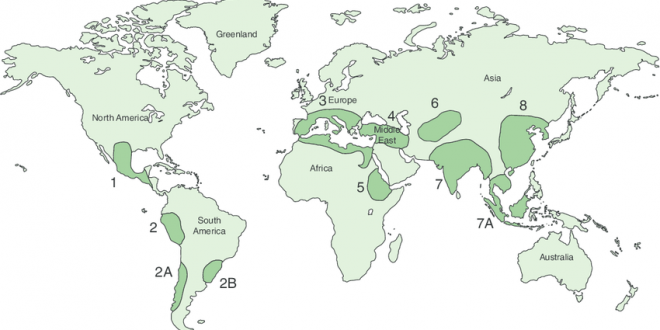What is Center of Origin?
The center of origin is a geographical area where the particular group of organisms (either domesticated or wild) first originated on earth.
Center of Origin & Center of Diversity
Many people believed that centers of origin are also centers of diversity. But, the centers of diversity may not represent the centers of origin of crop plants.
Although a few species may have been originated separately at more than one place, but most species had their origin at a certain place and then spread elsewhere.
In other words, in the center of origin a crop is generally confined to one place, whereas the center of diversity may be found at more than one place.
Best safe and secure cloud storage with password protection
Get Envato Elements, Prime Video, Hotstar and Netflix For Free
Best Money Earning Website 100$ Day
#1 Top ranking article submission website
Concept of centers of Origin

- The information on origin of crop plants is important in plant breeding to locate wild relatives, related species and new genes. Knowledge of the origins of crop plants is important to avoid genetic erosion, the loss of germplasm due to the loss of ecotypes and habitat.
- Nikolai Ivanovich Vavilov (25 November 1887 – 26 January 1943) was a prominent Russian and Soviet agronomist, botanist and geneticist best known for having identified the centres of origin of cultivated plants. He devoted his life to the study and improvement of wheat, corn, and other cereal crops that sustain the global population. The concept of centres of origin was developed by him in 1926. Vavilov elaborated on the work of Engelbrecht (1916) and considered the regions showing the greatest diversity with presence of wild relatives as the centres of origin of the crop plant.
- Vavilov and his colleagues visited several countries and collected a large number of crop plants and their wild relatives. They used this collection in Russian breeding programme of developing improved varieties. His deductions were based on evidences from morphology, anatomy, cytology, genetics, plant geography and distribution.
Vavilov’s work
Vavilov was a follower of De Candolle. He travelled over hundred locations around the world for germplasm collection and study crop variability.
- In 1920 he proposed the law of homologous series of variation, which states that the related species share certain common characters. Therefore, a character found in one species is expected to be observed in related species in a particular geographical area. E.g. absence of ligule in wheat and rye in Northern part of central Asia, while present in other regions.
- Vavilov noted that the centers of origin of cultivated plants occurred mostly in mountainous regions between the Tropic of Capricorn (23°28′) south of the equator and about 45°N of the equator in the Old World. In the New World crop domestication occurred between the two tropics (Cancer and Capricorn) approximately. In all cases agricultural origins and primitive diversity occurred in high and complex mountain regions.
- Vavilov was able to pinpoint the exact areas where crop plant diversity showed us the centers of origin of world crops.
- Vavilov considered that “as a rule the primary foci of crop origins were in mountainous regions, characterized by the presence of dominant alleles.” In his work entitled The Phytogeographical Basis for Plant Breeding (Vavilov 1935) he summarizes and pulls together all his previous work on centers of origin and diversity. In this he recognizes eight primary centers, as follows. These centers are still recognized in spite of several arguments against them.
Centers of Origin
- Primary Center: Where the crop has been actually domesticated- expected to be centers of diversity (8 primary centers)
- Secondary Center: Where it has been introduced from primary center and adapted to show high variation – often showing higher diversity of a particular crop than in its primary center ( 3 secondary centers)
|
Primary centers |
Secondary centers |
| Regions of vast genetic diversity of crop plants.
These are original homes of the crop plants which are generally uncultivated areas like, mountains, hills, river valleys, forests, etc. |
Vavilov suggested that valuable forms of crop plants are found far away from their primary area of origin which he called secondary centers of origin or diversity.
These are generally the cultivated areas. |
|
Main Features |
|
|
Primary centers |
Secondary centers |
| · Wide genetic diversity
· Large number of dominant genes · Wild characters · Exhibit less crossing over · Natural selection operates |
· Lesser genetic diversity
· Large number of recessive genes · Mostly desirable characters · Exhibit more crossing over · Both natural and artificial selections operate |
Refernce: Slideshare
Concepts of center of origin of cultivated crops (Part 2)
pay by phone bill casino app
 Plantlet The Blogging Platform of Department of Botany, University of Dhaka
Plantlet The Blogging Platform of Department of Botany, University of Dhaka






I am currently writing a paper that is very related to your content. I read your article and I have some questions. I would like to ask you. Can you answer me? I’ll keep an eye out for your reply. 20bet
Thank you so much for your Valuable comment. We wish to hear from you again and Sure we would love to help you.